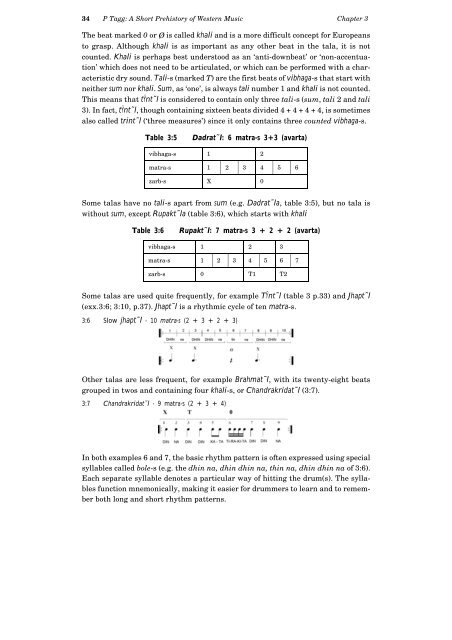A Short Prehistory of Western Music, Chapter 3
A Short Prehistory of Western Music, Chapter 3
A Short Prehistory of Western Music, Chapter 3
Create successful ePaper yourself
Turn your PDF publications into a flip-book with our unique Google optimized e-Paper software.
34 P Tagg: A <strong>Short</strong> <strong>Prehistory</strong> <strong>of</strong> <strong>Western</strong> <strong>Music</strong> <strong>Chapter</strong> 3<br />
The beat marked 0 or Ø is called khali and is a more difficult concept for Europeans<br />
to grasp. Although khali is as important as any other beat in the tala, it is not<br />
counted. Khali is perhaps best understood as an ‘anti-downbeat’ or ‘non-accentuation’<br />
which does not need to be articulated, or which can be performed with a characteristic<br />
dry sound. Tali-s (marked T) are the first beats <strong>of</strong> vibhaga-s that start with<br />
neither sum nor khali. Sum, as ‘one’, is always tali number 1 and khali is not counted.<br />
This means that tŸnt˜l is considered to contain only three tali-s (sum, tali 2 and tali<br />
3). In fact, tŸnt˜l, though containing sixteen beats divided 4 + 4 + 4 + 4, is sometimes<br />
also called trint˜l (‘three measures’) since it only contains three counted vibhaga-s.<br />
Table 3:5 Dadrat˜l: 6 matra-s 3+3 (avarta)<br />
vibhaga-s 1 2<br />
matra-s 1 2 3 4 5 6<br />
zarb-s X 0<br />
Some talas have no tali-s apart from sum (e.g. Dadrat˜la, table 3:5), but no tala is<br />
without sum, except Rupakt˜la (table 3:6), which starts with khali<br />
Table 3:6 Rupakt˜l: 7 matra-s 3 + 2 + 2 (avarta)<br />
vibhaga-s 1 2 3<br />
matra-s 1 2 3 4 5 6 7<br />
zarb-s 0 T1 T2<br />
Some talas are used quite frequently, for example TŸnt˜l (table 3 p.33) and Jhapt˜l<br />
(exx.3:6; 3:10, p.37). Jhapt˜l is a rhythmic cycle <strong>of</strong> ten matra-s.<br />
3:6 Slow jhapt˜l - 10 matra-s (2 + 3 + 2 + 3)<br />
Other talas are less frequent, for example Brahmat˜l, with its twenty-eight beats<br />
grouped in twos and containing four khali-s, or Chandrakridat˜l (3:7).<br />
3:7 Chandrakridat˜l - 9 matra-s (2 + 3 + 4)<br />
In both examples 6 and 7, the basic rhythm pattern is <strong>of</strong>ten expressed using special<br />
syllables called bole-s (e.g. the dhin na, dhin dhin na, thin na, dhin dhin na <strong>of</strong> 3:6).<br />
Each separate syllable denotes a particular way <strong>of</strong> hitting the drum(s). The syllables<br />
function mnemonically, making it easier for drummers to learn and to remember<br />
both long and short rhythm patterns.














